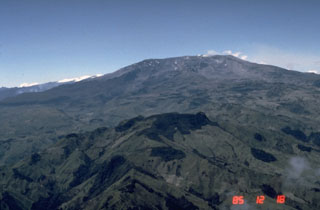Report on Nevado del Ruiz (Colombia) — December 1989
Scientific Event Alert Network Bulletin, vol. 14, no. 12 (December 1989)
Managing Editor: Lindsay McClelland.
Nevado del Ruiz (Colombia) Small ash ejections; seismicity remains stable
Please cite this report as:
Global Volcanism Program, 1989. Report on Nevado del Ruiz (Colombia) (McClelland, L., ed.). Scientific Event Alert Network Bulletin, 14:12. Smithsonian Institution. https://doi.org/10.5479/si.GVP.SEAN198912-351020
Nevado del Ruiz
Colombia
4.892°N, 75.324°W; summit elev. 5279 m
All times are local (unless otherwise noted)
Seismicity dropped in late September, reaching the lowest level since early 1988 in October, and remained at low to moderate levels in November. Seismic activity remained relatively stable in December, with no significant changes in the daily number of high- or low-frequency earthquakes. The energy release of low-frequency events increased slightly toward the end of the month, while the energy released by high-frequency events decreased slightly. High-frequency events were centered in three zones; N of, beneath, and scattered around Arenas Crater at 1-6 km depth. Swarms of these events occurred on the 16th and 18th. Short pulses of low-energy tremor were associated with small ash emissions, one of which deposited a thin layer of ash over Manizales (30 km from Arenas crater) on the 27th. Dry and electronic tilt and short leveling vectors showed no significant variations. SO2 emissions measured by COSPEC were moderate, averaging 1,800 t/d.
Geological Summary. Nevado del Ruiz is a broad, glacier-covered volcano in central Colombia that covers more than 200 km2. Three major edifices, composed of andesitic and dacitic lavas and andesitic pyroclastics, have been constructed since the beginning of the Pleistocene. The modern cone consists of a broad cluster of lava domes built within the caldera of an older edifice. The 1-km-wide, 240-m-deep Arenas crater occupies the summit. The prominent La Olleta pyroclastic cone located on the SW flank may also have been active in historical time. Steep headwalls of massive landslides cut the flanks. Melting of its summit icecap during historical eruptions, which date back to the 16th century, has resulted in devastating lahars, including one in 1985 that was South America's deadliest eruption.
Information Contacts: C. Carvajal, INGEOMINAS, Manizales.

